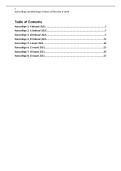1
Hoorcollege aantekeningen Culture & Diversity at work
Table of Contents
Hoorcollege 1: 4 februari 2021...........................................................................................2
Hoorcollege 2: 11 februari 2021.........................................................................................5
Hoorcollege 3: 18 februari 2021.........................................................................................9
Hoorcollege 4: 25 februari 2021.......................................................................................13
Hoorcollege 5: 4 maart 2021............................................................................................18
Hoorcollege 6: 11 maart 2021..........................................................................................23
Hoorcollege 7: 18 maart 2021..........................................................................................28
Hoorcollege 8: 25 maart 2021..........................................................................................33
,2
Hoorcollege aantekeningen Culture & Diversity at work
Hoorcollege 1: 4 februari 2021
The study culture & diversity at work
- Social psychological processes that play a role in the field of work and organizations with regard
to culture and diversity
- Why? Because the world is getting more diverse (women in the work field, different cultures,
etc.)
What is diversity?
- Diversity: everything that distinguishes people from one another
o Benefits: effective decision making, innovation, economic growth
o Challenges: bias in recruitment, selection, promotion (for example: if you have a foreign
name, you do not get invited to an interview while someone with a local name and same
CV would get invited) transparency is a key on how to address challenges
- In practice we focus on gender, age, race/ethnicity, religion, tenure, educational background,
and social/functional background
- Surface-level diversity: differences among group members in overt, biological characteristics that
are typically reflected in physical features
o For example: age, gender, and race/ethnicity
- Deep-level diversity: more subtle attributes that cannot necessarily be directly and immediately
observed. Such attributes refer to members’ personalities, attitudes, beliefs and values
o For example: sexual orientation, religious beliefs (exception if you can see signs of
religion, for example a hijab)
History of diversity in the workspace
- Workspace was domain of white males
- Assimilation of others into this environment (as opposed to integration) you need to be
similar to the in-group that you’re going to (assimilation=all the same in a group)
- Changes in population:
o Changes in working population
o Changes in consumer base/clientele
What has changed?
- More female employees
- More ethnic minorities
- More employees with disabilities
- More explicitly gay and lesbian individuals (LGBTQ)
- Increasingly international workforce
- Need to maintain older employees (retirement etc)
- And other forms of diversification
Examples of diversity on the work floor in The Netherlands: gender
- Gender Equality Index: composite indicator that measures the complex concept of gender
equality and, based on the EU policy framework, assist in monitoring progress of gender equality
across the EU over time (a score of 100 means perfect equality)
o European Union: 67.9 GEI
o The Netherlands: 74.1 GEI
- Low participation of women
o More women who work part-time then man (70% vs 17%)
- Few full-timers among women
o Not per se bad, depends on who you ask (some women want to work part-time)
- Few women in higher positions
o Under 50% marge of women in higher management
,3
Hoorcollege aantekeningen Culture & Diversity at work
- High gender segregation in sectors
o The leaking pipeline more men, less
women balance
Examples of diversity on the work floor in The
Netherlands: ethnicity
- Dutch population: +- 17 million people
- Who is considered to have a migration
background? on or two parents born abroad
- Western and non-western immigrants
differences in status
- Migration in the Netherlands is growing in
contrast to the natural local growth
Social-economic position of men vs women, 2018
- Dutch high SES, then people with a Western migration background high SES, people with a non-
western migration background low SES
Examples of diversity on the work floor in The Netherlands: age (older workers, 55-64 years)
- Participation older workers (women and men) is growing
- Average compared to other European countries participation still low
- Unemployment older workers > unemployment younger workers
Why organizations work with diversity
- Moral reasons
o Equal treatment
o Equal opportunity
o Equal outcomes
o Also cruelty free and Fairtrade (economic power)
- Societal reasons
o Emphasize good outcomes (that are not necessarily moral)
o Focus on consequences of inequality (practical) if the people/society are getting more
diverse, then a diverse team will help react to the needs and urges of the people/society
- Compliance: you have to comply with the rules, the action or fact of complying with a with or
command, comply with the law (for example: 30% female on the bord)
- Synergic reasons want to create synergy
, 4
Hoorcollege aantekeningen Culture & Diversity at work
o Relationship between employee and organization
o Personal and business economic growth
o Employee satisfaction
o Harmony among employees
- Business-economic reasons (the busines-case for diversity) more diversity = more money
o Attract diverse employees
o Increase service to diverse populations
o Increase retention of employees
o Improve relations between employees
o Increase creativity and productivity
o Reduce lawsuits/legal challenges
o Enhance reputation
Challenges approach to diversity at work
Old perspective New perspective
Focus on recruitment Working with diversity
Moral arguments (‘you should be equal’) Business-economic reasons
Diversity was a burden Diversity is a benefit
Ethnicity/gender differences All kinds of differences
White males as guilty Universality of bias (more factors)
Learning about culture has advantages Learning about people as individuals
‘Golden’ rule (treat others like you want to be ‘Platinum’ rule (I should treat you like you want to
treated yourself) I am the norm be treated) you are the norm
Assimilation Pluralism (integration)
What working with diversity is not …
- Just cultural differences
- Just employee selection
- Reducing requirements
- Simply blaming white males (part of the problem, but the not the problem)
Summary
- There is a substantial and growing diversity in the population
- Less diversity in the labour market, especially at highest levels
o Differences in labour participation and position regarding gender, ethnicity, and age
- Organisations increasingly working with diversity
o Different reasons
o Shifting approach




